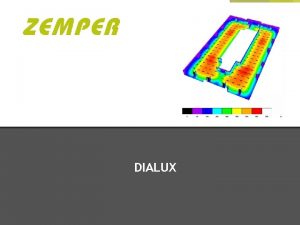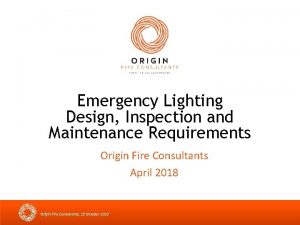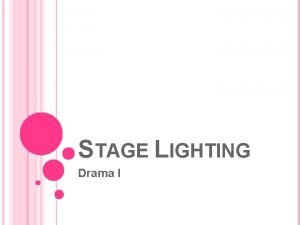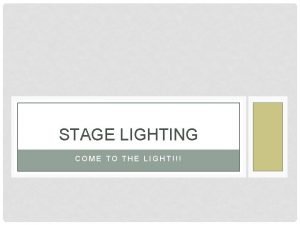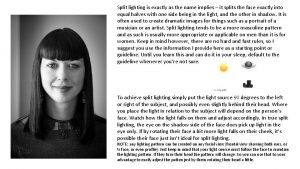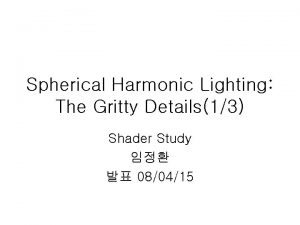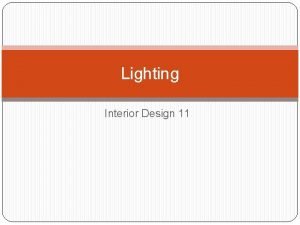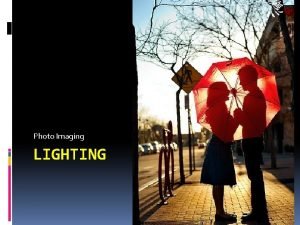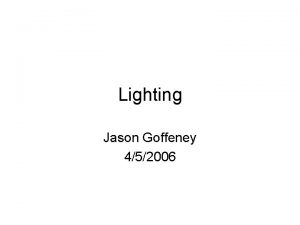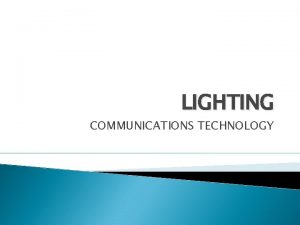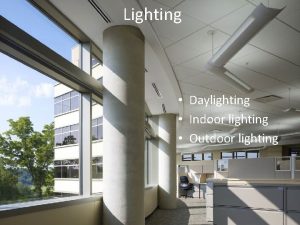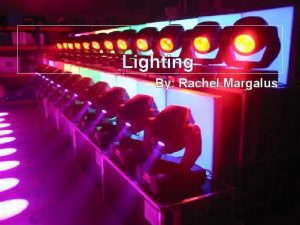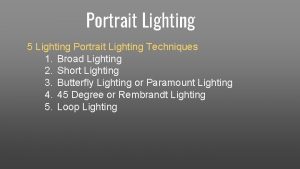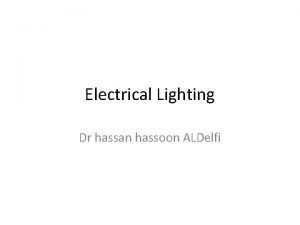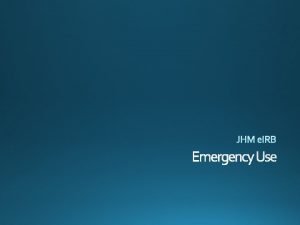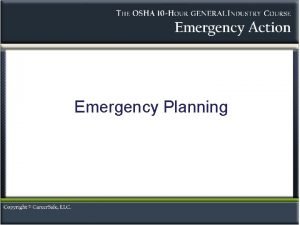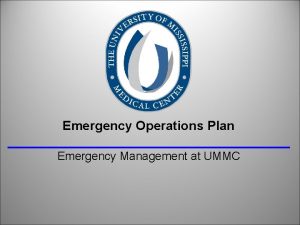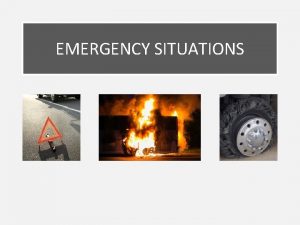GENSTAR LIGHTING EMERGENCY LIGHTING WHY IS EMERGENCY LIGHTING














- Slides: 14

GENSTAR LIGHTING EMERGENCY LIGHTING

WHY IS EMERGENCY LIGHTING REQUIRED An Emergency Lighting System is essential: § § § To clearly show all evacuation routes from a building To allow safe movement (to exits) moving at walking pace without stumbling To help prevent panic in an emergency and during evacuation To show the location of and identify all fire equipment and manual call points To permit safety operations such as administering first aid Emergency lighting is a requirement of law to enable people to safely evacuate a building as quickly as possible. Using illuminated signage to show escape route/s is a mandatory aspect of emergency lighting as these signs must be visible during a local or mains power failure. In addition, emergency lighting has to illuminate any fire equipment, such as fire hose reels; portable extinguishers and manual call points, whether on evacuation routes or elsewhere and permit safety operations such as first aid and fire fighting.

SOUTH AFRICAN EMERGENCY LIGHTING STANDARDS & REGULATIONS Emergency Lighting installations must at all times comply with the following standards: § § § Occupational Health and Safety Act (85 of 1993 as amended) SANS 10114 -2 Interior Lighting Part 2: Emergency Lighting SANS 1464 -22 Safety of Luminaire Part 22: Luminaire for Emergency Lighting SANS 1186 -3 (Symbolic Safety Signs) SANS 10400 -T Fire Protection

SOUTH AFRICAN EMERGENCY LIGHTING STANDARDS & REGULATIONS COMPARISON

SANS 10114 -2 Interior Lighting Part 2: Emergency Lighting - Detail

SANS 10114 -2 Interior Lighting Part 2: Emergency Lighting - Mandatory Points of Reference Any point on an escape route, or leading to it, must have an illuminated exit sign, so that the direction of travel is not in doubt. Exit signs should clearly identify the full extent of the escape route, including any changes of direction. Emergency lighting must be provided along escape routes, and in open areas leading to them, to enable people to move quickly and safely to an exit. Specific locations where emergency lighting must be provided for are: • • • Near to and outside each final exit All staircases (long flights might require multiple luminaires At or near each change of direction At or near each change of floor level Open areas greater than 60 m 2 At each intersection of the escape route corridor Within 2 m of each fire call point and each item of fire equipment Within 2 m of each first aid point An internally illuminated sign at each exit door “Near” is described as being within 2 m measured in the horizontal direction. Exit signs are to be mounted at a height of 2 to 2. 5 m above floor level

SANS 10114 -2 Interior Lighting Part 2: Emergency Lighting - Emergency Signs Emergency signs shall be used to ensure that, in an emergency, an escape route can be easily identified and followed from any position in the premises. When direct line of sight to the exit is not possible and/or if there could be any doubt as to the direction of the nearest exit, directional internally illuminated signs shall be provided and strategically placed to guide people towards the exit. Emergency signs shall comply with the appropriate requirements of SANS 1186 -3 (Internally Illuminated signs) When any building is occupied, any mark or sign as referred to in SANS 10400 -T 4. 29. 1 which is not internally illuminated shall be externally illuminated to a minimum intensity of 50 lux.

SANS 10114 -2 Interior Lighting Part 2: Emergency Lighting - Emergency Signs One of the major concerns we encounter is the confusion amongst electrical contractors, electrical engineers, building owners and facility managers as to how photoluminescent (PL) escape and exit signage may be used PL signs must produce a minimum 50 Lux on the sign face Emergency and Exit lighting is an essential life safety device and the non-compliance to the various regulations regarding correct product, placement and usage jeopardises the safety of building occupants. Internally illuminated sign Externally illuminated photoluminescent sign to a minimum of 50 lux on the sign face

SANS 10114 -2 Interior Lighting Part 2: Emergency Lighting - Signage Viewing Distance For all formats of exit lights and signs, the maximum viewing distance and luminance conditions are given in SANS 10114 -2 Interior Lighting Part 2 Exit lights must be placed at any change in direction, to indicate the route to the final exit door. The viewing distance is the distance from which the sign can be clearly seen and understood The minimum height of an internally illuminated exit sign is calculated with the formula: D = 200 x h, were d = viewing distance, h = height of the sign in mm. For example, a 150 mm high internally illuminated sign gives a viewing distance of 30 m The formula for an externally illuminated photoluminescent sign is D = 100 x h. Therefore, half the viewing distance to an equally sized internally illuminated sign. The installation of a photoluminescent exit sign therefore requires the installation of two luminaires The cost of installation and maintenance will increase unnecessarily.

SANS 10114 -2 Interior Lighting Part 2: Emergency Lighting - Exit Signage STAIRS: each tread should receive direct light from the emergency Lighting luminaire(s) so that the minimum luminance on each tread is 1 lux DIRECTION: emergency luminaires are required at each change of direction as well as near each intersection of corridors on the escape route LEVEL: steps or other changes of level should receive direct light from an emergency lighting luminaire ESCAPE SIGNS: escape signs may be either internally or externally illuminated to ensure they are conspicuous and legible to a minimum 20 lux of the sign

SANS 10114 -2 Interior Lighting Part 2: Emergency Lighting - Mandatory Emergency Lighting LIFTCARS: at least 3 hour dedicated emergency luminaire is required in each lift car FIRE FIGHTING EQUIPMENT & MANUAL CALL POINTS: emergency luminaires are required at each piece of fire fighting equipment and manual call point FIRST AID: emergency luminaires are required at each first aid point FINAL EXIT: The escape route outside of a final exit(s) to a place of safety shall be illuminated with emergency luminaires (this would include an extended outdoor pathway with hazards such as an adjacent fence with solid obstructive posts until reaching a place of safety)

SANS 10114 -2 Interior Lighting Part 2: Emergency Lighting - Clause 8. Drawings and Log Book Drawings of emergency lighting installations shall be provided and retained on the premises. Such drawings should be regularly updated to reflect any changes. LOG BOOK: A log book shall be at all times kept on the premises in the care of a responsible person nominated by the building owner/occupant and shall be readily available for inspection by any duly authorised person. The log book must record the following information: a) b) c) d) e) f) The date of commissioning including any certificate relating to alterations The date and details of each service, inspection or test carried out The date and details of any defects and remedial action taken The date and details of any alteration to the emergency lighting installation If a self-test device is used, a description of the performance of that device and The date and details of the annual tests for duration of operation, illumination and system recovery

SANS 10114 -2 Interior Lighting Part 2: Emergency Lighting - Clause 9. Routine Inspection and Tests There is a high possibility that the normal power supply might fail shortly after a period of testing of the emergency lighting system or during the subsequent recharge period, therefore it is prudent, whenever possible, to conduct all extended duration tests during times of low risk to allow for battery recharge. Alternatively, suitable temporary arrangements shall be made until the batteries have been recharged. The following minimum inspections and tests shall be carried out according to the following intervals: MONTHLY: A monthly inspection shall be carried out in accordance with a pre-determined schedule Self-Testing Devices: Inspection reports on self-testing devices shall be compiled monthly. Detection of any failure during testing by or of an automatic testing device shall be shown in the reports. Luminaires without Self-Testing Devices: Tests shall be carried out as follows: • Illuminate each luminaire and internally illuminated exit sign from its battery by simulating a failure of the normal power supply by tripping the necessary circuit breakers for a sufficient period to ensure that each lamp is illuminated. The duration of the simulated failure should not exceed ¼ of the rated duration of the luminaire or sign. Check all luminaires and signs that they are lit, clean and functioning correctly. Once complete, switch the circuit breakers on and check indicator lamp or device to ensure that normal mains supply has been restored. • In the case of central battery systems (UPS), check the correct operation of the system by tripping the mains • In the case of generating units a one hour tripping of the normal power supply is required for testing purposes

SANS 10114 -2 Interior Lighting Part 2: Emergency Lighting - Clause 9. Routine Inspection and Tests ANNUALLY: In addition to the monthly inspection outlined in the previous page, annual tests and checks are required as detailed below: Test each luminaire and internally illuminated sign as detailed previously but for the full rated duration of each device. For example, if a device has a 3 hour rated duration, the normal power supply is to be tripped for 3 hours. Once complete, restore the normal power supply and check that devices are operating correctly. With generating units, check indicator lamps or device to ensure that the units are functioning correctly. Refill fuel tanks, oil and coolant to ensure ultimate working condition. Record the date and the results of the tests in the log book To date and after numerous audits conducted at various commercial, industrial and retail entities, we are yet to find a logbook in use.
 Why why why why
Why why why why Dialux emergency lighting tutorial
Dialux emergency lighting tutorial Emergency lighting design nz
Emergency lighting design nz Dont ask why why why
Dont ask why why why Why-why analysis
Why-why analysis Why do you cry willie
Why do you cry willie Does the table represent a function why or why not
Does the table represent a function why or why not Does the table represent a function why or why not
Does the table represent a function why or why not Why or why not
Why or why not Analisa akar masalah
Analisa akar masalah Mccandless lighting
Mccandless lighting 4 functions of stage lighting
4 functions of stage lighting Split lighting
Split lighting Precomputed radiance transfer
Precomputed radiance transfer Spherical harmonic lighting
Spherical harmonic lighting

